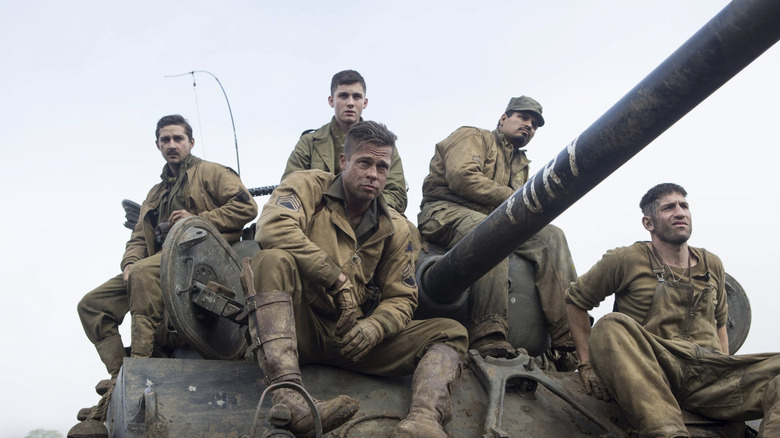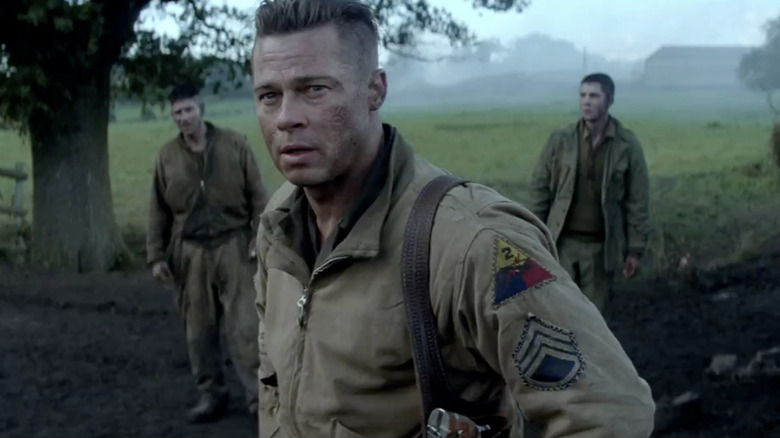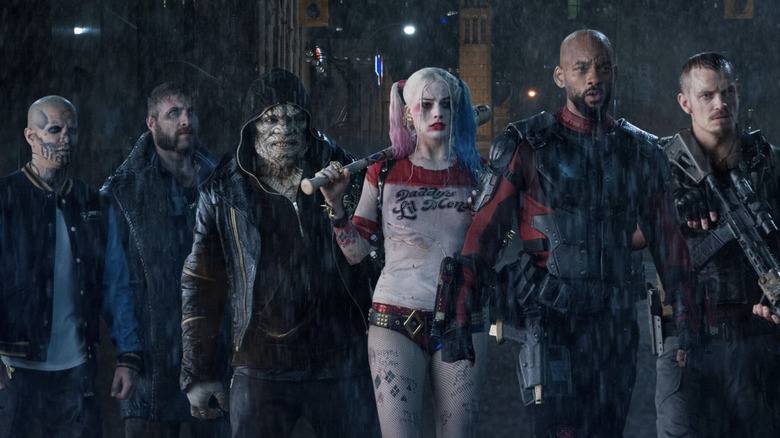Brad Pitt Was Building His Fury Backstory Long Before Filming Began
David Ayer's films are known for the amount of preparation that goes into developing relationships between characters. The onscreen chemistry in films like "End of Watch" and "Training Day" is credited to the intense pre-production that Ayer puts his actors through, and Ayer used the same process for his 2014 film "Fury," which follows a tank commando led by Brad Pitt's Don "Wardaddy" Collier. Pitt and the rest of the cast, which consisted of Jon Bernthal, Shia LaBeouf, Michael Peña, and Logan Lerman, underwent rigorous boot camp training to prepare for the film, and that training was an opportunity for them to bond as actors.
Aside from those interpersonal relationships, Ayer was also dedicated to making the characters as authentic as possible by developing their backstory. This was especially true for Brad Pitt's character, Wardaddy, whose backstory was developed a good while before production on the film even began — and often delivered to him in pieces via email in the middle of the night.
An experience like no other
In an interview for the British Film Institute, Brad Pitt described the thorough process he and Ayer went through when developing his character. When asked if the process of creating Don Collier's backstory started as soon as he signed on to play the part, Pitt replied:
"Yes, immediately. And I would get emails at, like, three in the morning. But [David Ayer] is a bit of a maniac in that way and demands full immersion, and created an experience for us that was unlike anything I've gotten to experience before, and quite remarkable. And in the process, the five of us became really tight and learned to operate a Sherman tank."
David Ayer's need for total immersion is a large part of why many of his films have something of a gritty realism to them. Movies like "Harsh Times" and "Training Day" are filled with morally ambiguous characters that have a level of authenticity that similar films in their genres lack. "Fury" shows the development of a bond between fighters and a loss of innocence with Lerman's character Norman, who starts the film having no combat experience but by the end has been fully immersed in the horrors of war. The powerful chemistry between the characters only makes the film's tragic ending hit even harder.
A process that delivers mixed results
David Ayer's 2016 film "Suicide Squad" used a similar method to "Fury" for preparing the cast to work together. When speaking to Entertainment Weekly about the process, Ayer described it as uncomfortable, but effective:
"It can't be [comfortable.] You've got to open up. Actors are super cagey. 'I'm not going to let you see any of my tools until I get to set, and then I'm going to surprise you because they are so awesome.' [My approach is more], 'No, No. Let's burn through the toolbox now and start making some new tools.'"
However, whether because of studio interference or other problems, "Suicide Squad" did not come across as nearly authentic as "Fury" in terms of the camaraderie between characters. "Suicide Squad" has been at the forefront of discussions about comic book movies that missed the mark, with the characters considered by many to be one-dimensional. Lines like "this is Katana, she's got my back" and "here comes Slipknot, the man who can climb anything" became memes because they were pretty much the only development those characters got.
So, Ayer's process of making actors vulnerable to one another while also developing their backstories seems to be hit-and-miss. However, "Fury" is definitely an example of a hit, and Brad Pitt and the rest of the cast seem to have come out of the experience for the better.


